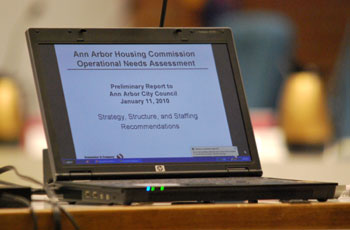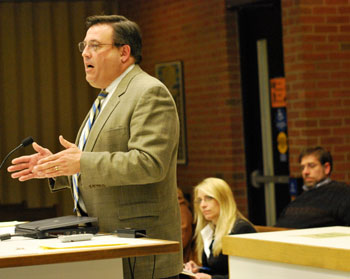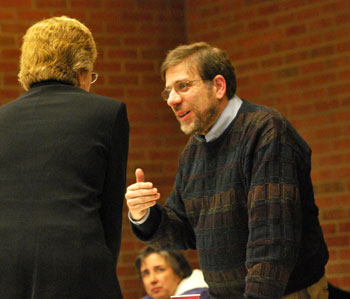Housing Commission Reorganizes
Ann Arbor City Council work session (Jan. 11, 2010): Ann Arbor city councilmembers were presented on Monday evening with an outline for the reorganization of the city’s housing commission, a plan that has in large part already been adopted by the commission and needs no further city council approval.
The housing commission is responsible for 355 public housing units spread over 18 sites – or around 50% of the affordable housing stock in the city – plus 1,300 Section 8 vouchers for a three-county area.

Kerry Laycock, the consultant who gave the city council a presentation on the reorganization of the housing commission, gave a slide presentation from the podium using this laptop computer. (Photos by the writer.)
Keys to the reorganization are beefing up the Section 8 program with a dedicated financial analyst and a program manager, and redefining roles of the executive director and deputy director, as well as outsourcing maintenance of the housing units.
Outsourcing maintenance will reduce the housing commission staff by six people – two temporary employees plus four union workers.
Alan Levy, who chairs the housing commission board, told councilmembers that the reorganization had already been approved by a 3-2 vote of the housing commission’s board at a special meeting held on Jan. 6, 2010.
The two dissenting votes, Levy said, were in overall support of the plan, but had reservations about the union employees whose positions with the housing commission would be eliminated.

Kerry Laycock, at the podium, gives the city council the grim verdict from a needs assessment he helped conduct of the Ann Arbor housing commission. Seated are Marge Novak, interim executive director of AAHC, and Alan Levy, chair of the AAHC board.
The need to reorganize, Levy told the council, was prompted by a difficult last few years dealing with personnel and staffing issues, as well as chronic underfunding of the U.S. Department of Housing and Urban Development (HUD).
What was the city council’s role in the reorganization? At its May 18, 2009 meeting, the city council had approved a contract with Schumaker & Company for $117,040 to perform a needs assessment for the housing commission. It’s the result of that recommendation that led to the adopted reorganization.
And for the next two years, the council may be asked to help bridge a $138,163 funding gap to help with the transition as the commission reorganizes.
Anecdotal Indicator of Public Housing Conditions
In the course of deliberations, mayor John Hieftje gave one anecdotal indicator that the housing commission was already beginning to turn the corner on some of its past difficulties.
He told his council colleagues that a couple of years ago, residents of Ann Arbor’s public housing had begun to visit his Friday open office hours to share complaints with him.
And Tony Derezinski (Ward 2), who serves as the council liaison to the city’s housing commission, described the housing commission’s situation during his most recent period of service as “a trying year.” He summarized it by saying, “It was a mess.”
However, Derezinski described the appointment of Marge Novak as interim executive director in May 2009 as “a godsend,” while emphasizing that the housing commission was still not “out of the woods.”
Hieftje said that six to nine months ago, the visits by public housing residents to his weekly office hour had stopped. Why had they shown up in the first place?
Problems with the Housing Commission
Kerry Laycock spoke on behalf of the consultant that had performed the needs assessment – Schumaker & Company. In the course of his presentation, he painted a picture that could fairly be described as grim.
That assessment had been based on staff interviews, community/stakeholder interviews, focus groups with public housing residents, financial analyses and benchmarking with other communities.
Measured against its mission statement, Laycock told the council, the housing commission was not doing that well. The commission’s mission statement reads [emphasis added for readability]:
Mission Statement
Ann Arbor Housing Commission (AAHC) seeks to provide desirable housing and related supportive services for low-income individuals and families on a transitional and/or permanent basis. AAHC will partner with housing and service providers to build healthy residential communities and promote an atmosphere of pride and responsibility.
But Laycock described a commission that provided desirable housing only in the sense that there were many people who needed a place to live and were signed up for a spot – the properties themselves, he said, were outdated and poorly maintained.
The supportive services provided were limited and not meeting the current needs of residents, he said. And he described the housing commission as a relatively isolated agency that had limited interaction with other community organizations and programs.
Some of the challenges faced by AAHC, Laycock acknowledged, were a result of an environment of relative instability caused by HUD. By its own measure, he said, HUD funds its programs at a level of 82% of what they need. The underfunding, plus the fact that funding decisions are made late in the year, had led to less-than-optimal operations by AAHC.
Given the unstable environment of HUD, Laycock said, it was important to secure additional funding, outside of HUD. Because AAHC had not done that, he continued, it was not able to make up for the HUD shortfall, nor provide support services needed by the residents of its housing, nor keep up on important maintenance and modernization of its housing stock. His presentation described the housing stock as amendable to better maintenance, but as outdated and inherently substandard.
Laycock described one approach to updating public housing as tearing it down and starting from scratch – an approach that had been taken in Grand Rapids, he said. However, Stephen Kunselman (Ward 3) drew out the fact that in Grand Rapids, the housing commission had been separated out from the city’s administration – something that Laycock’s analysis did not recommend. If anything, Laycock said, the AAHC should have a closer relationship with the city.
Adopted Solutions: Staffing and Maintenance
Laycock identified the key strategic objectives of 1) rehabilitating and redeveloping AAHC properties, 2) expanding funding to include non-HUD sources, 3) strengthening of support services, 4) improving management oversight and 5) improving internal efficiencies.
The reorganization adopted by the housing commission seeks to realize these objectives by redefining and adding administrative staff roles (a plus of two positions), while outsourcing maintenance of the properties (a minus of six positions).
Staff Roles
To understand the additions to the city housing commission staff that have been adopted, it’s useful to understand the distinction between the public housing versus the Section 8 part of the AAHC mission.
The low-income public housing component of the AAHC mission involves ownership, maintenance and management of places for people to live. The Section 8 housing choice voucher (HCV) program, on the other hand, is a voucher system – those who are served by the program receive a voucher that can be used to pay rent to a private landlord. In the Section 8 program, prospective tenants contact landlords directly, and landlords are supposed to screen tenants the same way they would those without vouchers.
The arithmetic of staff additions would add a financial analyst to the Section 8 program. Together with the upgrading to financial analyst of a current accounting clerk position for public housing, that would give each of the housing commission’s programs a financial analyst. Laycock described the advantage of the analyst over a clerk position: An analyst can interpret and summarize financial data and make recommendations – as opposed to a clerk, whose responsibility is more limited to recording and inputting data.
The second additional position would also go to support the Section 8 program in the form of a separate manager of that program.
Besides adding positions, the reorganization redefines the roles of staff, from site managers up to the executive director level. Site managers would no longer supervise maintenance staff – but they’d still have a relationship with the vendor for outsourced maintenance. The strategy will be to relieve these on-site managers of maintenance-employee supervision so that they can focus more squarely on meeting residents’ needs. That refocusing of task is reflected in a job title change from site manager to residency manager.
The executive director and the deputy director would be made regular full-time positions. The executive director will be less focused on operations than in the past, with a primary responsibility for strategic planning, rehabilitation of existing housing, and development of new housing. The deputy director will split time between operations and grant writing. Winning grants is seen as key to bridging the HUD funding gap, as well as eventually covering the increased staffing costs of the reorganization.

Marge Novak, interim executive director of Ann Arbor's housing commission, explains to the city council that part of the goal of reorganization is to secure additional grant funding.
Optimism that there was grant money available that the AAHC commission was not currently exploiting – due to a lack of grant-writing resources – came from interim executive director of AAHC, Marge Novak. Sandi Smith (Ward 1) clarified with Novak that the AAHC was currently “leaving money on the table.”
And winning grants was the answer to a question Carsten Hohnke (Ward 5) had about how much funding the city council might be asked to provide over time – operations were ongoing expenses every year, he cautioned. The city council’s prior commitment to the housing commission for FY 2010 and FY 2011 is $90,000, but the financial implications of the reorganization – adding people and expanding existing roles – will amount to $228,163.
In his comments, mayor John Hieftje characterized the strategy as spending a little money in the short term in order to get someone in place who can go after more money in the form of grants.
The options for addressing the $138,163 difference, Laycock said, included using AAHC reserves, looking at funds held by affiliated nonprofits, using in-kind services from the city of Ann Arbor, and the sale/lease of maintenance vehicles as a part of the outsourcing contract. But Laycock gave city councilmembers a heads-up on Monday night that the AAHC could be asking them for money from the Ann Arbor general fund as well. That’s why Hohnke wondered if the request would be one that was repeated into the future.
Laycock and Novak seemed confident that the investment in grant writing resources would pay off – any additional request from the city council would be confined to achieving the transition to the new, reorganized housing commission.

Alan Levy, chair of the Ann Arbor housing commission board, clarifies a point with Jayne Miller, community services area administrator. In the background is Joan Doughty, director of the Community Action Network (CAN).
Also a part of the transition strategy would be the addition of new positions as more funds become available. Jayne Miller, community services area administrator, told the council that the time frame for the transition to financial sustainability was expected to be about two years.
Maintenance Outsourcing
Also a part of the gradual approach to the transition is the change to outsourced maintenance. There are two temporary positions that would be eliminated as soon as an initial contract with a maintenance vendor is signed. But four other American Federation of State, County and Municipal Employees (AFSCME) union positions would be absorbed elsewhere in the city workforce as positions become available.
Another aspect of the gradualness of the transition is that an outside vendor for maintenance will first engage in a pilot project that encompasses work currently done by two temporary employees – at a single building or site. The outside vendor would then assume additional work as the AFSCME positions transition to other positions within the city.
In his presentation, Laycock characterized the move to outsourced maintenance as the most controversial aspect of the reorganization, but stressed that is was not a matter of chasing dollars – the idea is to provide better maintenance of the properties.
There would be a request for proposals (RFP) process for the outside maintenance vendor, Laycock said, and he saw that as an opportunity for partnering with other agencies. He did not elaborate on that, saying that he did not want that possibility to affect the RFP process.
Councilmember Questions on AAHC
Other commentary by councilmembers covered a range of topics.
Potential Partnerships
The relative isolation of the AAHC from other entities with complementary missions was identified as a problem in the operational needs assessment.

Carsten Hohnke (Ward 5) asks for clarification about the potential for partnerships by the housing commission with other agencies.
So Carsten Hohnke (Ward 5) asked where the potential for partnerships was. Interim executive director Marge Novak described how some collaborations already existed – with Peace Neighborhood Center and Community Action Network (CAN). Further, she described how the county’s Employment Training & Community Services (ETCS) department provided meals to two of the public housing locations – Miller Manor and Baker Commons.
Alan Levy, chair of the AAHC board, added later that there was a memorandum of understanding with the Interfaith Hospitality Network that allowed three referrals per year on a priority basis for the homeless, with no wait-listing required.
Wait-lists
From Mike Anglin (Ward 5) came a question about wait-list times. Novak said that for public housing, the wait-list was around 700 people and that there were a couple hundred on the wait-list for Section 8. The Section 8 wait-list, Novak told the council, had not been open “in years.” The public housing wait-list had been opened a few times over the last few years. [Currently, the city of Ann Arbor's website indicates that the wait-list for public housing is closed.]
The city council had been asked earlier in the fall to approve a measure that allocated funds on an emergency basis to provide housing vouchers for homeless families. At Monday’s working session, Sandi Smith (Ward 1) wanted to know if these were the same kind of vouchers. Novak said that those came through the office of city/county community development. But Section 8 did include family vouchers, Novak clarified.
Smith also wanted to know if the problem with Section 8 wait-listing was a lack of supply – are there enough landlords? Novak described the problem as the hundreds of people who are waiting for vouchers as the larger issue. She said there were around 1,000 landlords in the three-county area who had properties available.
How Does Ann Arbor and Its City Council Fit In?
From both Ward 3 council representatives – Christopher Taylor and Stephen Kunselman – came questions about the nature of the city’s relationship to the housing commission and the council’s role specifically. After hearing Laycock explain that the housing commission had adopted the reorganization and that the council did not need to approve it, Kunselman asked: “What is our responsibility?”
Jayne Miller, community services area administrator, clarified that there was no funding responsibility – HUD is the funding agency. However, Miller continued, the city council approved appointments to the housing commission’s board. Further, she said, the city council had invested considerable resources in its commitment to affordable housing, and the housing commission was responsible for around half of all affordable housing units in the city.
Taylor wondered what the structure of the housing commission was with respect to the city’s actual organization. Specifically, Taylor was interested in how the housing commission’s staff related to the city’s bargaining units. [In his presentation, Laycock had described how part of the reorganization plan entailed a recommendation to adopt a compensation policy that would put pay at 90% of the market midpoint.]
In responding to Taylor, Laycock clarified that housing commission staff were, in fact, city employees. As such, he said, every mandate for Ann Arbor city employees applies to them – with no independent ability to attach any funding to those mandates. The HUD program, which involves a federal department that relies on local authorities, which in turn provide oversight to additional entities, was characterized by Laycock as a prescription for confusion.
Taylor also picked up on a data point about Section 8 vouchers that emerged in the presentation: 70% of voucher recipients are non-Ann Arbor residents. Taylor wanted to know if the AAHC looked for funding from the communities where they do reside. The clarification was that HUD assigns areas of service to each authority and that the AAHC serves a three-county region.
Taylor also elicited the clarification that there is in some sense a “margin” of benefit provided by Section 8 to the public housing component of the AAHC. That is, funding for Section 8 administration helps cover costs associated with the public housing part of the AAHC.




“HUD assigns areas of service to each authority and that the AAHC serves a three-county region.”
If AAHC serves a 3-county region, are other municipalities kicking in to support it, or is Ann Arbor the only one?